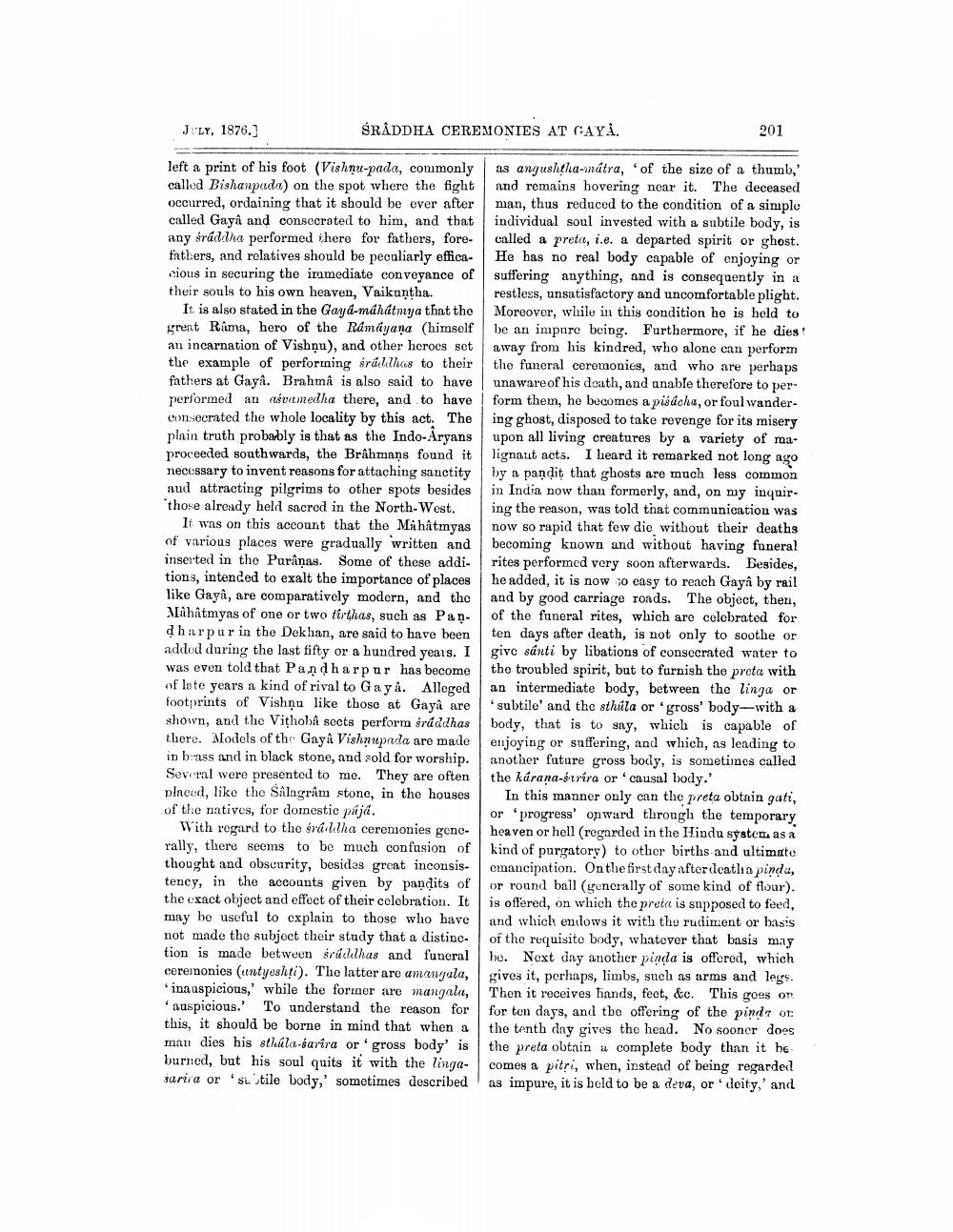________________
SRÅDDHA CEREMONIES AT GAYA.
as angushtha-mátra,
of the size of a thumb,' and remains hovering near it. The deceased man, thus reduced to the condition of a simple individual soul invested with a subtile body, is called a preta, i.e. a departed spirit or ghost. He has no real body capable of enjoying or suffering anything, and is consequently in a restless, unsatisfactory and uncomfortable plight. Moreover, while in this condition he is held to be an impure being. Furthermore, if he dies! away from his kindred, who alone can perform the funeral ceremonies, and who are perhaps unaware of his death, and unable therefore to perform them, he becomes a piédcha, or foul wandering ghost, disposed to take revenge for its misery upon all living creatures by a variety of malignant acts. I heard it remarked not long ago by a pandit that ghosts are much less common in India now than formerly, and, on my inquiring the reason, was told that communication was now so rapid that few die without their deaths becoming known and without having funeral rites performed very soon afterwards. Besides, he added, it is now so easy to reach Gayâ by rail and by good carriage roads. The object, then, of the funeral rites, which are celebrated for ten days after death, is not only to soothe or give santi by libations of consecrated water to the troubled spirit, but to furnish the preta with an intermediate body, between the linga or subtile' and the sthula or 'gross' body-with a body, that is to say, which is capable of enjoying or suffering, and which, as leading to another future gross body, is sometimes called the kárana-strira or 'causal body.'
JULY, 1876.]
left a print of his foot (Vishnu-pada, commonly called Bishanpada) on the spot where the fight occurred, ordaining that it should be ever after called Gayâ and consecrated to him, and that any śraddha performed there for fathers, forefathers, and relatives should be peculiarly efficacious in securing the immediate conveyance of their souls to his own heaven, Vaikuntha.
It is also stated in the Gayd-máhatmya that the great Rama, hero of the Rámáyana (himself an incarnation of Vishnu), and other heroes set the example of performing śradhas to their fathers at Gayâ. Brahmâ is also said to have performed an aévamedha there, and to have consecrated the whole locality by this act. The plain truth probably is that as the Indo-Aryans proceeded southwards, the Brâhmans found it necessary to invent reasons for attaching sanctity and attracting pilgrims to other spots besides those already held sacred in the North-West.
It was on this account that the Mahatmyas of various places were gradually written and inserted in the Purâņas. Some of these additions, intended to exalt the importance of places like Gaya, are comparatively modern, and the Mahatmyas of one or two tirthas, such as Pandharpur in the Dekhan, are said to have been added during the last fifty or a hundred years. I was even told that Pandharpur has become of late years a kind of rival to Gay â. Alleged footprints of Vishnu like those at Gayà are shown, and the Vithobâ sects perform śráddhas there. Models of the Gaya Vishnupada are made in brass and in black stone, and sold for worship. Several were presented to me. They are often placed, like the Sâlagrâm stone, in the houses of the natives, for domestic pájá.
With regard to the śrállha ceremonies generally, there seems to be much confusion of thought and obscurity, besides great inconsistency, in the accounts given by pandits of the exact object and effect of their colebration. It may be useful to explain to those who have not made the subject their study that a distinction is made between śraddhas and funeral ceremonies (untyeshti). The latter are amangala, inauspicious,' while the former are mangala, auspicious. To understand the reason for this, it should be borne in mind that when a man dies his sthúla-sarira or gross body' is burned, but his soul quits it with the lingasarira or stile body,' sometimes described
201
In this manner only can the preta obtain gati, or 'progress' onward through the temporary heaven or hell (regarded in the Hindu system as a kind of purgatory) to other births and ultimate emancipation. On the first day after death a pinda, or round ball (generally of some kind of flour). is offered, on which the preta is supposed to feed, and which endows it with the rudiment or basis of the requisite body, whatever that basis may he. Next day another pinda is offered, which gives it, perhaps, limbs, such as arms and legs. Then it receives hands, feet, &c. This goes on for ten days, and the offering of the pinda or the tenth day gives the head. No sooner does the preta obtain a complete body than it be comes a pitri, when, instead of being regarded as impure, it is held to be a deva, or' deity,' and




